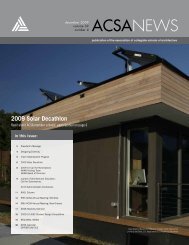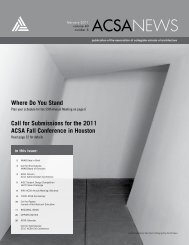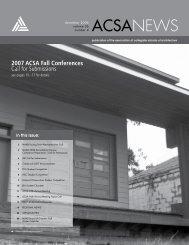digital aptitudes - Association of Collegiate Schools of Architecture
digital aptitudes - Association of Collegiate Schools of Architecture
digital aptitudes - Association of Collegiate Schools of Architecture
You also want an ePaper? Increase the reach of your titles
YUMPU automatically turns print PDFs into web optimized ePapers that Google loves.
THURSDAY, MARCH 1, 2012 - 12:00PM - 1:30PM<br />
Open: History/Theory<br />
Vittoria Di Palma, Columbia University<br />
Blow-Up: <strong>Architecture</strong> and the Technology <strong>of</strong><br />
Contemporary Art<br />
Nora Wendl, Portland State University<br />
Isabelle Wallace, University <strong>of</strong> Georgia<br />
The contemporary architectural reading <strong>of</strong> technology as instrumental<br />
is far removed from the Greek origins <strong>of</strong> the word, techne,<br />
knowledge related to making. The danger—and the opportunity—<br />
<strong>of</strong> such instrumental thinking is that it reduces architectural practice<br />
to a series <strong>of</strong> specialized strategies or operations that can be<br />
done by anyone, opening it up to appropriation. Appropriating the<br />
strategies and operations <strong>of</strong> architecture has been, for artists from<br />
the 1960s forward, the most direct method <strong>of</strong> institutional critique,<br />
a radical turn on the historical relationship between art and architecture<br />
through which art has <strong>of</strong>ten been the necessary vehicle, the<br />
technology, by which the perception, representation and the making<br />
<strong>of</strong> architecture is transformed.<br />
Over the last twenty-five years, art has become more than a technique<br />
to embellish or advance architectural form, it has become a<br />
site for architecture’s analysis. For, although architecture has always<br />
been a motif within the visual arts, in increasing numbers, and as<br />
if in response to architecture’s own willingness to picture itself—a<br />
willingness that begins in the Postmodern era— architecture is now<br />
the explicit subject <strong>of</strong> much visual art across media. Consequently,<br />
and as this paper will examine, a certain faction <strong>of</strong> contemporary art<br />
can be viewed as a silent compliment to the acknowledged history<br />
<strong>of</strong> the built environment—a non-verbal form <strong>of</strong> architectural history,<br />
a legitimate site <strong>of</strong> interpretation, criticism, and analysis—and, as this<br />
paper will argue, a technology through which architecture is experienced,<br />
theorized, historicized and disseminated.<br />
Digital Ecstasy: <strong>Architecture</strong> in the Post-Fordist era<br />
Elie Haddad, Lebanese American University<br />
Nadir Lahiji, Pennsylvania State University<br />
For three decades, academia and pr<strong>of</strong>essional architectural establishments<br />
have euphorically embraced exactly what this ACSA conference,<br />
in celebration <strong>of</strong> its hundredth anniversary, has termed as<br />
“<strong>digital</strong> aptitude.” Without a doubt, the imperatives <strong>of</strong> the postmodern<br />
culture have brought to the fore a gifted generation with an incomparable<br />
skill and talent to manipulate new <strong>digital</strong> technologies<br />
for design practices. But, significantly, the same gifted generation<br />
has demonstrated a parallel talent corollary with the first, which we<br />
shall call “political inaptitude.” We claim that this political inaptitude<br />
is the dialectical opposite, or the negative obverse, <strong>of</strong> the same <strong>digital</strong><br />
aptitude underlying postmodern design practices. In this paper<br />
we will attempt to critique this new design approach, which simultaneously<br />
displays both sides <strong>of</strong> this dialectic. We begin by posing this<br />
question: should the <strong>digital</strong> aptitude be necessarily accompanied<br />
by a separation from the ‘political’, a separation that is one <strong>of</strong> the<br />
symptoms <strong>of</strong> our society <strong>of</strong> the spectacle? Our initial answer to this<br />
question is an emphatic No! We will argue against this inauspicious<br />
separation and examine some <strong>of</strong> its theoretical causes.<br />
Leftovers: Residual and Risk in “Our Digital Present”<br />
Jasmine Benyamin, Texas A&M University<br />
Despite the so called ‘post-critical’ moment <strong>of</strong> our <strong>digital</strong> present,<br />
those <strong>of</strong> us who are more involved in thinking about buildings than<br />
in their making may find opportunities for critical inquiry after all,<br />
thereby avoiding the risk <strong>of</strong> disciplinary extinction. In this essay I<br />
propose possible avenues for a critical re-engagement with current<br />
practice, through the lens <strong>of</strong> residual and risk. Further, I argue that<br />
how we write and talk about buildings needs to undergo a paradigmatic<br />
shift, since the way buildings are made has fundamentally<br />
altered. In fact, given the current emphasis on process over<br />
representation, we have a renewed responsibility to inquire about<br />
the changing paradigms <strong>of</strong> authorship in current practice, but also<br />
in our thinking about practice. What are the implications <strong>of</strong> collaborative<br />
process-based practice on (singular) authorial subject?<br />
Does the notion <strong>of</strong> process itself so central to emergent technologies<br />
risk the loss <strong>of</strong> the author? Can authorship be re-defined and<br />
re-inscribed in process if not in outmoded notions <strong>of</strong> intent? This,<br />
after all, must not kill that.<br />
Digital Apptitutes + Other Openings - Boston, MA - 7








